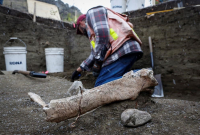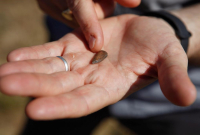Support strong Canadian climate journalism for 2025
In what is being called a major archeological discovery, excavations for a condominium project in Quebec City have uncovered a fortification dating back to 1693.
Preserved in clay for centuries, the 20-metre section was part of a wood palisade built to defend against possible attacks from the English and from Indigenous groups.
Premier Francois Legault, who announced the find at a news conference Tuesday, said it is inspiring to see how Quebec's ancestors worked to protect the colony of New France.
The discovery is "an occasion to highlight our history," he said.
"(We) can't forget that we are a nation that has managed to maintain its place for 400 years."
Legault was joined by two of his cabinet ministers and Quebec City Mayor Regis Labeaume for the announcement.
Culture Minister Nathalie Roy said she hopes the public will eventually have access to the site.
Labeaume said the discovery would permit historians to better understand the system of fortifications erected by the French in the settlement that would later become Quebec City.
Historians say about 500 people worked on building the wall in a settlement that had just 800 people at the time.
The government plans to remove the structure and eventually put it on display. The waterlogged wood will first have to be dried, which is expected to take two years. The cost of the necessary restoration work was not disclosed.
The discovery was made recently under Ste-Ursule Street, inside the walls of the old city.





Comments